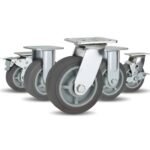A door hinge is a crucial component that connects a door to its frame, allowing it to swing open and closed easily. Typically made up of two plates—one attached to the door frame and the other to the door—along with a pivot pin for rotation, hinges come in various shapes, sizes, and styles to suit both residential and commercial needs.
Types of Door Hinges
Here’s a look at some of the most commonly used types of door hinges:
1. Ball-Bearing Hinge
Ball-bearing hinges are a type of butt hinge that features hidden bearings between the knuckles. This design reduces friction, allowing doors to move smoothly. They are heavy-duty and ideal for entry doors due to their durability.

2. Barrel Hinge

Perfect for projects where you want to conceal the hinges, barrel hinges are often used in box-like cabinets. Typically made of brass, they are compact and allow doors to open 180 degrees, but they aren’t suitable for heavy loads.
3. Butt Hinge

The most common hinge type, butt hinges consist of two rectangular leaves connected by a pin. They come in various styles, including plain bearing, ball-bearing, spring-loaded, and rising, making them versatile for both standard and cabinet doors.
4. Concealed Hinge

Also known as invisible or European hinges, concealed hinges offer a sleek, uninterrupted look. They can be adjusted after installation, making them perfect for modern cabinets and furniture, and they provide added security since they can’t be tampered with from the outside.
5. Heavy Duty Hinge

These hinges are designed to support heavy doors, such as entry doors and gates. Heavy-duty options are available in various styles, including ball-bearing and concealed hinges, ensuring stability for frequently used doors.
6. Knife Hinge

Knife hinges are commonly found in cabinets and resemble the blades of scissors. They integrate with pivot points, making them discreet and ideal for overlay or inset doors, so they remain nearly invisible after installation.
7. Piano Hinge

A continuous hinge, piano hinges are perfect for bifold or concertina doors, as well as workbenches and desks. They provide support along the entire length of the door and are fitted into drilled holes for a clean look.
8. Pivot Hinge

Pivot hinges are attached to the top and bottom of a door, allowing it to swing from a single point. They are great for heavier doors and are often used in homes and restaurants for easy access between spaces.
9. Strap Hinge
Strap hinges are characterized by their long, narrow leaves and are often used outdoors on gates to provide extra stability. They can also serve as stylish design elements for interior cabinet doors.
10. Offset Hinge

Offset hinges allow a door to swing away from the frame, widening the opening by up to two inches. This feature is especially useful for making doorways more accessible, including for ADA compliance.
12. Overlay Hinge

These hinges are designed to minimize the thickness added to cabinetry. Overlay hinges fold back without contributing to the overall thickness, making them ideal for a streamlined look.
13. Cylinder Hinge / Invisible Hinge

Cylinder hinges allow a door to open a full 180 degrees, making them ideal for bifold or concertina doors. When closed, they remain hidden from view, providing a clean and modern aesthetic.
With so many types of hinges available, you can choose the perfect one to enhance both the functionality and style of your doors!





Leave a Reply